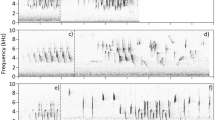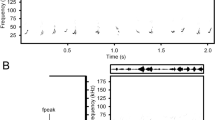Summary
The paper deals with a physical analysis of the calls of Sigara striata and Callicorixa praeusta (Corixidae) and observations on the biological function of their phonobehaviour.
-
1.
Stridulation is associated with reproductive behaviour. The males emit a calling song, which may also have a gathering function, and is then called congregational song.
-
2.
As a rule, the songs of all males, singing together, are synchronised, as it is characteristic for social insects.
-
3.
Both species have two different methods of stridulating and thus produce two distinct calls, though they evidently have no different information.
-
4.
The call of Sigara striata contents a chirp-verse (1.5–3.2 sec) and a whettingverse (1.6–6.3 sec). The frequency range of both is 3–15 kc, but there is a difference in the temporal arrangement of the syllables. The call of Callicorixa praeusta has also a frequency range of 3–15 kc, but the temporal structure differs from that of Sigara striata (2.7–4.6 sec).
-
5.
The acoustical IRM of the species was investigated with sound-traps.
-
6.
The variability in the structure of the calls and their dependence on watertemperature have been analysed.
-
7.
A sound produced by females was observed. It accompanies a movement of the hind legs and perhaps may be an answer to the male calls.
Zusammenfassung
Der physikalische Aufbau der Gesänge von Sigara striata und Callicorixa praeusta wurde analysiert und Beobachtungen über die biologische Bedeutung ihres bioakustischen Verhaltens angestellt.
-
1.
Die Stridulation steht im Dienst der Fortpflanzung. Es handelt sich um einen sog. Normalgesang (calling-, common song) mit Übergang zum Kongregationsgesang.
-
2.
Die Gesänge von Sigara striata und Callicorixa praeusta sind ein Beispiel für synchrone Lautäußerungen, die für gesellig lebende Tiere typisch sind.
-
3.
Bei beiden Arten treten zwei Stridulationsmethoden und damit verbunden zwei Motive auf, denen jedoch keine nachweisbare unterschiedliche Bedeutung zukommt.
-
4.
Der Gesang von Sigara striata besteht aus einem „Zirpmotiv“ (1,5–3,2 sec) und einem „Wetzmotiv“ (1,6–6,3 sec). Die Frequenzverteilung liegt für beide Motive bei 3–15 kHz, sie unterscheiden sich aber in der zeitlichen Aufeinanderfolge der Silben. Die Lautäußerung von Callicorixa praeusta hat eine Frequenzbreite von 3 bis 15 kHz, bei einer Länge von 2,7–4,6 sec, jedoch eine von Sigara striata abweichende rhythmische Gliederung der Laute.
-
5.
Die Weite des akustischen AAM der beiden Arten wurde mit Hilfe von Lautattrappen festgelegt.
-
6.
Die natürliche Schwankungsbreite der Komponenten der Lautäußerungen und ihre Temperaturabhängigkeit wurden festgestellt.
-
7.
Eine Lautäußerung von ♀♀ wurde beobachtet. Es handelt sich um das Begleitgeräusch einer Bewegung der Hinterbeine, das möglicherweise als Antwortverhalten-Bedeutung hat.
Similar content being viewed by others
Literatur
Autrum, H.: Über Lautäußerung und Schallwahrnehmung bei Arthropoden. I. Untersuchungen an Ameisen. Eine allgemeine Theorie der Schallwahrnehmung bei Arthropoden. Z. vergl. Physiol. 23, 323–373 (1936).
—: Über Lautäußerungen und Schallwahrnehmung bei Arthropoden. II. Das Richtungshören von Locusta und Versuch einer Hörtheorie für Tympanalorgane vom Locustidentyp. Z. vergl. Physiol. 28, 326–352 (1941).
—: Über Gehör und Erschütterungssinn bei Locustiden. Z. vergl. Physiol. 28, 580–637 (1941).
—, u. W. Schneider: Vergleichende Untersuchungen über den Erschütterungssinn der Insekten. Z. vergl. Physiol. 31, 77–88 (1948).
Benwitz, G.: Der Kopf von Corixa punctata Ill. Zool. Jb., Abt. Anat. u. Ontog. 75, 312–378 (1956).
Busnel, M.-C., M. Degrois et R.-G. Busnel: Variations des Stridulations de Locusta migratoria mâle, selon la patte utilisée par l'insecte. Physiol. Comp. Oecol. 3, 18–24 (1953).
Busnel, R.-G.: Étude de l'un des caractères physiques essentiels des signaux acoustiques réactogènes artificiels sur les orthoptères et d'autres groupes d'insectes. Insectes sociaux 3, 11–16 (1956).
—: Acoustic behaviour of animals. Amsterdam: Elsevier 1963.
Faber, A.: Die Lautäußerungen der Orthopteren. II. Z. Morph. Ökol. Tiere 26, I, (1932).
—: Laut- und Gebärdensprache bei Insekten. Orthoptera I. Stuttgart: Staatl. Mus. f. Naturkunde 1953.
Frings, H., and M. Frings: Uses of sounds by insects. Ann. Rev. Entomol. 3, 87–106 (1958).
Goertz, M. E.: Sound production in two sympatric species of aquatic Hemiptera, Buenoa macrotibialis (Hung.) and Buenoa confusa. Thesis, Dartmouth College, Hanover, New Hampshire (1963).
Hagemann, J.: Beiträge zur Kenntnis von Corixa. Zool. Jb., Abt. Anat. u. Ontog. 30, 373–421 (1910).
Handlirsch, A.: Zur Kenntnis der Stridulationsorgane bei den Rhynchoten. Ann. naturhist. Mus. Wien 15, 127–141 (1900).
Haskell, P. T.: Hearing in certainOrthoptera. J. exp. Biol. Edinb. 33, 756–766, 767–776 (1956).
—: Insect sounds. Chicago: Quadrangle Books 1961.
Huber, F.: Heuschrecken- und Grillenlaute und ihre Bedeutung. Naturwissenschaften 43, 14, 2317 (1956).
Hungerford, H. B.: The biology and ecology of aquatic and semiaquatic Hemiptera. Bull. Kans. Univ. Sci. 11, 1–341 (1919).
—: The Corixidae of the Western hemisphere. Bull. Kans. Univ. Sci. 32, 1–827 (1948).
Karny, H.: Biologie der Wasserinsekten. Wien: Wagner 1934.
Larsen, O.: Untersuchungen über den Geschlechtsapparat der aquatilen Wanzen. Opuscula entomologica I. Lund 1938.
—: Truncale Scolopalorgane in den pterothorakalen und den beiden ersten abdominalen Segmenten der aquatilen Heteropteren. Acta Univ. Lundensis (Lund) (2) 53, 1–68 (1957).
Loher, W.: Untersuchungen über den Aufbau und die Entstehung der Gesänge einiger Feldheuschreckenarten und den Einfluß von Lautzeichen auf das akustische Verhalten. Z. vergl. Physiol. 39, 313–356 (1957).
Mitis, H. V.: Zur Biologie der Corixiden, Stridulation. Z. Morph. Ökol. Tiere 30, 479–495 (1936).
Mittenecker, E.: Planung und statistische Auswertung von Experimenten. Wien: Deuticke 1963.
Pielemeier, W. H.: Supersonic insects. J. acoust. Soc. Amer. 17, No 4 (1946).
Poisson, R.: Les Hémiptères aquatiles Sandaliorrhyncha Börn. de la faune franccaise. Arch. Zool. exp. gén. 77, 455–563 (1935).
Popham, E. J.: On the respiration of aquatic Hemiptera Heteroptera with special reference to the Corixidae. Proc. zool. Soc. Lond. 135, Part 2, 209–242 (1960).
—: The function of the paleal pegs of Corixidae (Hemiptera Heteroptera). Nature (Lond.) 190, No 4777, 742–743 (1961).
Schaller, F.: Lauterzeugung und Hörvermögen von Corixa (Callicorixa) striata L. Z. vergl. Physiol. 33, 476–486 (1951).
Southwood, T. R. E., and D. Lesion: Land and water bugs of British isles. London: Warne 1959.
Sutton, M. F.: On the food, feeding mechanism and alimentary canal of Corixidae (Hemiptera Heteroptera). Proc. zoo. Soc. Lond. 121, 465–499 (1951).
Wotzel, F.: Zur Kenntnis der Tympanalorgane der Hydrocores. Z. wiss. Zool. (Leipzig) 143, (1933).
Zwart, K. W. R.: On the influence of some food substances on the survival of Corixidae (Heteroptera). Proc. XII. Int. Congr. Ent. London 1964, p. 411–412 (1965).
Author information
Authors and Affiliations
Rights and permissions
About this article
Cite this article
Finke, C. Lautäußerungen und Verhalten von Sigara striata und Callicorixa praeusta (Corixidae Leach., Hydrocorisae Latr.). Zeitschrift für vergleichende Physiologie 58, 398–422 (1968). https://doi.org/10.1007/BF00343513
Received:
Issue Date:
DOI: https://doi.org/10.1007/BF00343513




